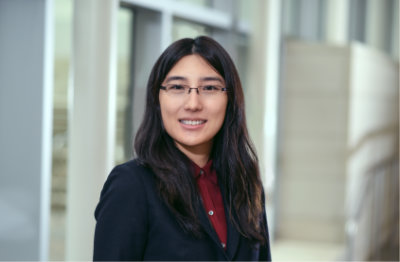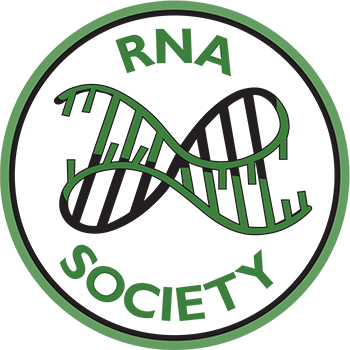Dr. Angela YuWritten by: Yuk Kei Wan Posted: May 5, 2025  Dr. Angela Yu recently started her lab in the Therapeutic Innovation Center (THINC) and the Verna and Marrs McLean Department of Biochemistry and Molecular Pharmacology at Baylor College of Medicine (BCM). She is particularly excited to apply machine learning and artificial intelligence to understand and modulate RNA structure and regulation in disease contexts. She believes that this area of research shows huge potential for improving health outcomes and treating diseases. She is inspired by Professor Adrian Krainer, who translated knowledge of basic RNA regulation into a working therapeutic that both extended lifespan and improved quality of life of patients. Working within an RNA center located in the Texas Medical Center, world’s largest medical center, Dr. Yu believes that this environment fosters great collaboration opportunities with her supportive colleagues towards translational research. Dr. Angela Yu’s interest in RNA research was first sparked in high school, when she learned about the work of 2006 Nobel Prize in Physiology awardees Professor Andrew Fire and Professor Craig Mello, demonstrating a new type of RNA-based RNA regulating mechanism. Mind-blown by the central dogma being more complicated than what was taught at the high-school level, Dr. Angela Yu pursued her undergraduate studies in Computational Biology at the University of Pennsylvania, known for its long history in education and research and proximity to medical research centers. As a freshman, Dr. Angela Yu had no prior research experience and was thankful for Professor Brian Gregory’s taking her into his lab. This, she describes as “the greatest impact moment of her career path”, opened the door to the research world to her. At the Gregory lab, Dr. Angela Yu worked on two projects, where the computational steps to achieve the final goals were not entirely spelled out, requiring creativity and curiosity in problem solving. She is thankful to receive much research guidance from Dr. Matthew Willmann, a former postdoc in the lab, who patiently trained her through wet-lab experiments and gave her important context of the data, and Professor Brian Gregory, who advised her in her research progress and graduate school applications.
Before her senior year in college, Dr. Angela Yu went across the pond for her summer research internship at the University of Oxford. She remembered her summer group project on cotranscriptional RNA folding, which continually gave bleak results. Her research advisor asked her why she had not given up on the project, and she replied, “I’m just stubborn when it comes to my work.” She spent weeks thinking and trying out various ideas and eventually came up with an improved algorithm. Through her first research experiences during her undergraduate studies, Dr. Angela Yu cultivated self-perseverance, which she now characterizes as a key quality to achieve a research advance. After wrestling with the summer group project on cotranscriptional RNA folding, Dr. Angela Yu ended up loving the topic and joining Professor Julius Lucks' lab at Cornell University to study cotranscriptional folding of the E. coli signal recognition particle (SRP) RNA for six years during her PhD. Dr. Angela Yu explained SRP RNA (her favorite RNA!) is one of the few RNAs conserved in all kingdoms of life, whose functional form is a long helical structure, requiring the SRP RNA to get rid of the local structures during co-transcriptional folding to get to its functional structure. Collaborating across labs of Professor Julius Lucks, Professor Alan Chen, and Professor Venkat Gopalan, Dr. Angela Yu’s PhD work showed the E. coli SRP RNA’s folding pathway and how a single point mutation can trap this RNA from efficiently folding into its functional structure, which can be rescued with two additional point mutations. Furthermore, her work also showed that a cotranscriptional folding intermediate that’s associated with a pause site could be cleaved in vitro by recombinant E. coli RNase P, suggesting potential cotranscriptional processing which was previously thought for decades to be only posttranscriptional. With these discoveries, Dr. Angela Yu and collaborators proposed that the SRP RNA gets to its functional form through a toehold-mediated strand displacement mechanism. These findings are possible through Dr. Angela Yu’s method, Reconstructing RNA Dynamics from Data (R2D2) (which was selected for a research highlight on the NIH Director’s Blog) which she started developing as a rotational student. She is very proud of publishing this paper and the findings along the way, which snowballed into a much larger story than she initially imagined. Dr. Angela Yu acknowledges that Professor David Mathews’ work on the partition function calculation for RNA secondary structure described in the RNA Journal paper “Using an RNA secondary structure partition function to determine confidence in basepairs predicted by free energy minimization” sets a good foundation to her PhD work, as the algorithm described in this paper expands the consideration of RNA thermodynamic parameters and utilizes prior and/or experimental knowledge to constrain the calculation, enabling many uses cases in determining RNA base-pairing probabilities. Dr. Angela Yu said her time at the Lucks lab solidified her trajectory towards becoming an assistant professor. During her PhD years, Professor Julius Lucks included them in peer reviews, grant writing, and revisions, which gave her training on such tasks and a better insight into a job as a principal investigator. Furthermore, he encouraged and funded his trainees to go to conferences and present their work. Even after her PhD, Professor Julius Lucks provided Dr. Angela Yu advice during her faculty job search, for which she is incredibly grateful. She hopes to implement in her lab for future trainees the positives that she experienced during her PhD. After her PhD, Dr. Angela Yu joined Professor Georg Seelig’s lab at the University of Washington with the support from the Washington Research Foundation (WRF) Postdoctoral Fellowship, providing her three years of salary support and a research allowance. She joined the Seelig lab because she was fascinated by the group’s approach of combining high-throughput biology and machine learning to answer scientific questions. Furthermore, she found the Seelig lab a good fit as she hoped to not only grow in her computational skills but also dedicate time to pick up wet-lab skills while learning even more about RNA regulation. Dr. Angela Yu is grateful to Professor Georg Seelig for supporting her to pursue independence at the wet-lab bench. She presented her postdoctoral work at the RNA Society Annual Meeting in 2023 in Singapore with the support of the RNA Society Research Presentation Fellowship. Her favorite experience at the RNA Society Meeting was the mentor/mentee lunch, where the mentors’ insights helped her consider her next steps. She also found the pre-conference STEP-Ahead into an RNA World Workshop fantastic. As a computational biologist, Dr. Angela Yu highlights the importance of using computers to perform large amounts of computation operations with the ever-growing corpus of high-throughput experimental data, which in the context of RNA research, has allowed the studying of various facets of RNA regulations that would otherwise be unwieldy. Trained in mixed dry-and-wet labs, where communication between computational and experimental biologists is necessary and encouraged, Dr. Angela Yu thinks that both computational biologists and experimental biologists should have mutual respect, open minds, and patience as they work with one another as different people are trained with different skill sets and ways of approaching scientific problems. She advises to communicate one’s science with one another in an easily understandable way, actively ask questions, and look up terms and papers to better empathize how hard research can be from both computational and experimental angles. She believes computational and experimental biology will continue to synergize and provide impactful insights in the coming decades and is particularly excited about predictive computational models with higher resolution knowledge of multiple aspects of RNA biology that can be utilized to help cure disease. Now in Houston, Dr. Angela Yu is co-organizing a Biomolecular Artificial Intelligence Journal Club between Baylor College of Medicine and Rice University. This program is inspired by a journal club course she sat in, taught by leading AI/ML professors at the University of Washington. She found the course immensely helpful to get started in machine learning research through reading AI/ML-related papers. She noted the cross-institutional nature of the Biomolecular Artificial Intelligence Journal Club allows more scientific discourse. Dr. Angela Yu recognizes the importance of mentorship and sponsorship she has received since the start of her career as she said, “I would not be able to be where I am in my career without the mentorship and support of many individuals I have met and worked with throughout my career.” She hopes to provide good mentorship and support to the future trainees in her lab. Follow Dr. Angela Yu on Bluesky (https://bsky.app/profile/rna-lab.bsky.social) to stay updated with her latest research insights and experiences. |
